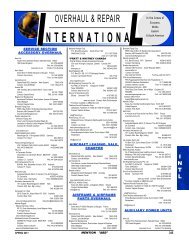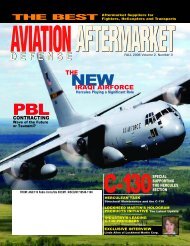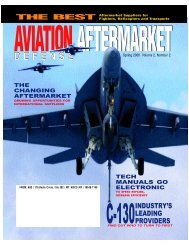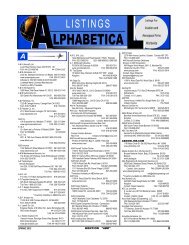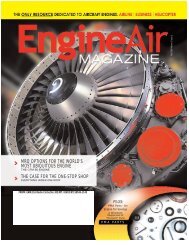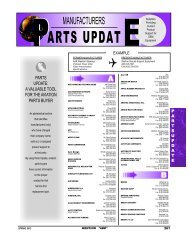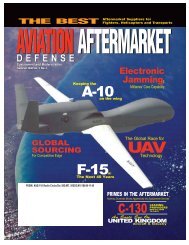Create successful ePaper yourself
Turn your PDF publications into a flip-book with our unique Google optimized e-Paper software.
A Global Hawk sits on the runway before<br />
beginning a nighttime mission. The aircraft is<br />
unmanned, and is used to capture imagery from<br />
high altitudes.<br />
the same company makes the<br />
Integrated Sensor Suite, which includes<br />
the electro-optical, infrared, and<br />
synthetic aperature radar imaging used<br />
on all RQ-4As. To keep them in top<br />
operational order, the seven primary<br />
sensor LRUs on the RQ-4 are hand<br />
massaged on a daily basis.<br />
Maintenance providers need<br />
replacement parts to keep aircraft<br />
flying, and this can be a problem for the<br />
current operational RQ-4, because<br />
there are only nine Block 10 models in<br />
the entire world. U.S. Navy Captain<br />
Robert Dishman, Program Manager for<br />
Persistent Maritime Unmanned Aircraft<br />
Systems, at Patuxent River Naval Air<br />
Station in Maryland, tells us that a daily<br />
report is circulated to all units involved<br />
with RQ-4 operations, providing the<br />
status and availability of critical parts<br />
used on the aircraft.<br />
Cannibalization is a fact of life for<br />
Block 10 RQ-4s, as these UAVs have<br />
been projected to be replaced by more<br />
capable follow-on variants since the<br />
program's inception. This results in a<br />
higher cannibalization rate than<br />
normally is considered acceptable for a<br />
weapons system intended for long-term<br />
use.<br />
The fuselage of the RQ-4 is<br />
aluminum, and the wings and<br />
empennage are composite and, as<br />
such, are pretty standard in terms of<br />
maintenance upkeep. The issue faced<br />
by maintainers is that the RQ-4, like any<br />
new aircraft, still is undergoing damage<br />
tolerance assessment; this results in the<br />
need for engineering dispositions from<br />
Northrop Grumman before making<br />
most related repairs.<br />
Technicians update maintenance<br />
manuals as they encounter and repair<br />
damage to the skin of the RQ-4 in order<br />
to continually improve its capabilities.<br />
For example, U.S. Navy BAMS RQ-4N<br />
aircraft will include leading-edge<br />
modifications, which have undergone<br />
hail and bird strike tests.<br />
Another difference between the<br />
U.S. Navy's planned BAMS version of<br />
the RQ-4B and the U.S. Air Force's<br />
Blocks 20-40 is the addition of leadingedge<br />
anti-icing and de-icing<br />
capabilities. Icing is a definite problem<br />
encountered in RQ-4 operations, so<br />
much so that the Air Force has lost<br />
quite a few sorties due to icing<br />
conditions.<br />
During initial design, the<br />
assumption was made that the aircraft<br />
would transit the icing regime quickly<br />
enough, so that ice buildup would not<br />
be an issue. It took further engineering<br />
analysis and in-flight experience to<br />
determine that was not the case;<br />
however, this still was unknown during<br />
initial reviews of the U.S. Air Force<br />
variants.<br />
As more data was available when<br />
the U.S. Navy went on contract, a<br />
requirement for anti-icing and de-icing<br />
features was added. Since retrofitting<br />
this desirable capability is expensive,<br />
the U.S. Air Force is looking at adding it<br />
to future production models.<br />
U.S. Navy RQ-4Ns also will have<br />
KEEPING THE RQ-4 IN THE AIR<br />
increased wing strength to allow for<br />
greater gust load environments and<br />
increase safety factors. This has been<br />
accomplished by adding several more<br />
layers of composite to the wings, while<br />
taking some of the thickness away from<br />
the wing spars. This tradeoff allows the<br />
wing shape to remain the same.<br />
Despite these subtle model<br />
differences, the U.S. Air Force and the<br />
U.S. Navy are working together in their<br />
RQ-4 operations around the world,<br />
sharing maintenance technicians, parts,<br />
and ground support equipment, such as<br />
the LRE (Launch and Recovery Element).<br />
Most important, the two services are<br />
sharing their experiences and ongoing<br />
information, with the goal of improving<br />
and maximizing the use of the versatile<br />
RQ-4.<br />
This cooperation is exemplified by<br />
the recent 380 Air Expeditionary Wing's<br />
addition of the first operational U.S.<br />
Navy RQ-4A. This joint mission is an<br />
outgrowth of the GHMD program,<br />
known as the Broad Area Maritime<br />
Surveillance Demonstrator.<br />
WWW.ABDONLINE.COM AVIATION AFTERMARKET <strong>DEFENSE</strong> | SPRING 2010<br />
AAD<br />
37<br />
Photo by John Schwab, Beale Air Force Base, California



